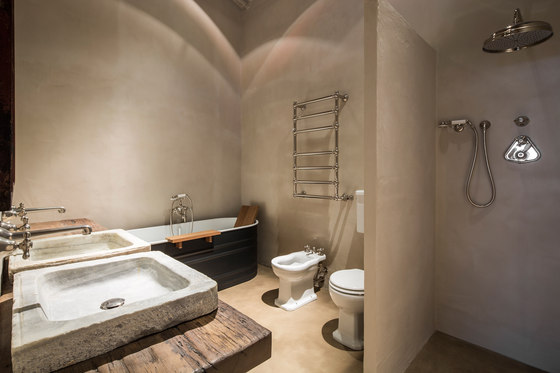Podere Navigliano is an antique tuscan farmhouse in the heart of Sienese Clays where nature and history are the undisputed protagonists. This project is the evolution of thought Smallness which characterized all previous projects of the office.
In this case especially the materials but also the attention to the historical context and the environment are at the heart of the project; the reinterpretation of traditional elements has allowed to find a new language, a new aesthetic inseparably linked to the tradition.
Smallness in this context means the ability to find, edit and innovate materials, construction techniques and technologies specific of the site. The design effort was aimed at the definition of a project that can interact with the environment and the tradition but at the same time able to surprise showing a new beauty, rediscovered in the elements of tradition itself.
The project involves the renovation of a farm of 600 sqm spread over three levels: a ground floor that was used as a stable and service areas for agriculture, a first floor that housed two apartments and a second floor, consisting of two turrets, at the service of the apartments. Through a new arrangement of the interior was recreated a single dwelling trying to respect the essential characteristics of the traditional type, which is why in the ground floor have been localized service spaces (tavern, laundry, SPA, garage), in the first floor the living area that overlooks the valley to the south and two suites that overlook the most intimate private garden, in the two towers were located the most valuable suites. Particular attention was paid to the choice of materials and in particular the floors are the key element of the intervention. The choice of floors and their positioning reflects the philosophy of the intervention.
On the ground floor, intended for local service, was selected the resin that is adopting the previous clay pavement and well suited to the new features. In the living area on the first floor had originally brick floors of low quality, following the demolition of all interior floors for structural reasons, it was decided to revive the brick; our research has led to the choice of different stock of brick recovery of the same size mixed in a new pattern to obtain a more appearance.
On the first floor and the second floor, in the bedroom, we have tried to reinterpret the tradition of woodworking proposing a cross and a diamond design recreated with the same logic of the brick floor, by assembling elements from wooden planks recovery of different essences, thus obtaining a pattern varied and uneven.
The steel is very important in this project, by structural element was brought to finishing element protagonist of the interior space. The corten staircase, the double-sided fireplace and steel hoops testify the intervention on the existing not trying to hide the scars but elevating them to characterizing element.
All the walls are finished with natural lime lying in traditional way in an irregular manner; to emphasize the beauty of the material has been chosen was decided not to paint the walls but to let the natural colour of lime.
All external facades have been treated and restored with the same lime and reproduce the aesthetics of its place except the facade of the main entrance that for structural reasons, it was rebuilt, in this case it was decided to change the system facade by inserting the element of jealousy used to illuminate the stairwell behind.
Architecture: Ciclostile Architettura
nterior: Edoardo Morelli
Landscape: Arch. Paolo Pejrone
Structure: EN7
Thermal installations: Ing. Massimiliano Marchesini
Electrical installations: Ing. Luca Nanni



























